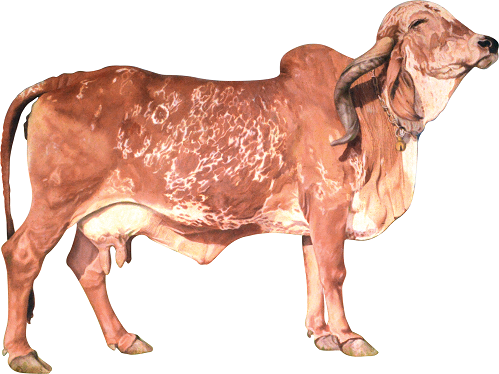The Gir cow is a famous Indian-born dairy cattle breed. Gir’s cattle native tract is Gir hills and forests of Kathiawar. This includes Gujarat districts of Amreli, Bhavnagar, Junagadh, and Jasdan. The name of the breed comes from the forest of Gir.
Outside India, gir cattle is also very popular. This breed was imported by the United States, Mexico, Venezuela and Brazil. And successfully they’re being bred there. The breed was also one of North America’s cattle breeds used to grow the Brahman cattle.
Description of Gir Cow:
The Gir cattle is an important Indian dairy cattle breed. They are very hardy and well-known for their tolerance to conditions of stress and resistance to various tropical diseases.
Gir bulls are used on all kinds of soil to pull heavy loads. By general, they are very gentle and polite, and love to be with people. The Gir cattle are very gregarious and form a very close circle at night with their calves sleeping under their heads. In India, it is a very popular breed of dairy cattle.
The average Gir Cow Milk production is 6-10 liters/day. Within India, the cows are also doing very well. They produce an average of 3,500 kg of milk per lactation in Brazil.
Gir cattle’s average lifespan is around 12-15 years. And during their lifetime, a cow develops 10-12 calves.
Physical Characteristics of Gir Cattle:
On average, the weight of Gir Bulls and Cows is approx 550-650 kg and 400-475 kg respectively. The height of the bull is 1.35m and the Gir cow’s height is 1.30m on average.
The color of their body is red to spotted white. Although, with large red spots, their body color may vary from pure red to yellowish red to white. Forehead of Gir Cow is like a bony shield, prominent, convex and broad.
Ears are long, pendulous and folded like a leaf on the tip with a knot. The horns are bent and turn back. The tail of the Cow is very long.
They have a prominent Hip Bone and high Hump that differs from other Cow breeds. Do you know that the HUMP in GIR Cow has a specific vein called “Surya Ketu Nadi” that is missing in Non-Gir cows and Hybrid cows.
Surya Ketu Nadi (Vein) produces gold salts in its blood when dealing with solar rays. Such salts are in the milk of the cow and the other body fluids of the cow.
Because the milk, butter, and ghee of the Gir cow have a natural golden color. In Ayurveda, Gir cow’s milk, Ghee, Curd, Urine, and Dung together are known as ‘Panchgavya’.
This is also very useful to fight and cure many human and animal diseases. From Surya Ketu Nadi, we can find many important properties:
MILK: Vitamins, Proteins, Minerals, Amino acids, phosphorus, Glucose, cerebrosides, strontyne, and Carotene with golden abstracts that are very helpful for our body.
DUNG: Nitrogen(N7), Potassium, Copper, Molybdenum, Borex, Cobalt Sulphate, Phosphorus, Irons, Manganese, Boron, Sodium. These properties of cow dung act as a natural fertilizer and are used as raw manure.
URINE: Calcium, Potassium, Magnesium, Phosphorus, Fluoride, Urea, Phosphorus, Ammonia. Regular consumption of cow urine can destroy the Cancer virus. Its urine helps to purify the body and keep the mind calm, which makes the body healthy. It is also helpful to prevent diseases.
https://youtu.be/5ew3pG-foR0


